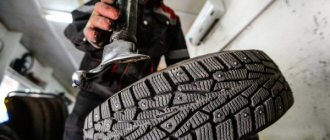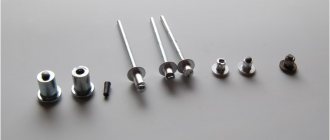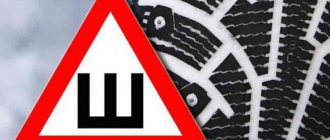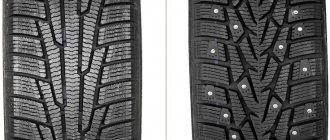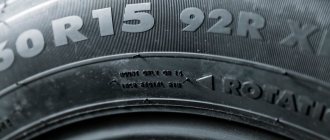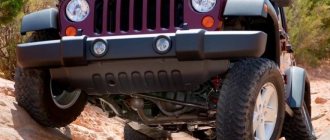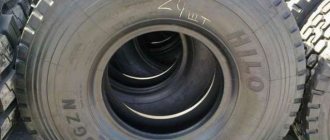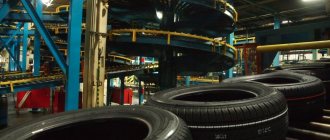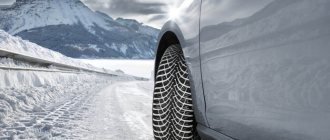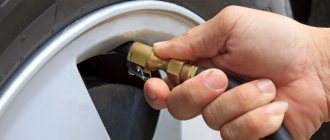Unfortunately, studs falling out of tires is a common situation. The loss of metal elements negatively affects the behavior of the car when driving on a winter road, and driving the vehicle can become dangerous. It is for this reason that maintaining studs on rubber is an important and urgent task.
Studded or non-studded tires: what to choose
Winter tires come in two types:
- studded tires. Its main difference is movement on ice or any other sliding road surface. Spikes made of durable metals create traction with the road surface.
- friction – models of these winter tires are becoming more and more popular and are increasingly being improved by manufacturers. For example, the multi-layer structure of tires is increasingly being used to ensure full compliance with snow-covered roads, icy surfaces, water with slush, and dry roads in severe frost conditions.
Comparison of studded and non-studded tires
Depending on the preferences of the car owner and a number of external factors, one or another type of tire is installed on car wheels in the winter. Below we will discuss the differences and characteristics of both types of tires, as well as factors that can influence the choice of the type of winter tires.
Why do you need winter studded tires?
Currently, one can observe how, with the onset of winter - and sometimes not even winter, but the very first cold weather - many motorists begin to urgently replace the tires on which their car is “shod”. This is quite understandable. Without “changing your shoes”, driving on the roads in winter is almost impossible for two reasons. The first of them is a large amount of snow. Not always and not everywhere is the snow removed at a level that would suit the driver. And then, you can always find a section of the road where the snow has not been removed. Even if this area is only one per hundred kilometers, this is quite enough to get stuck there and spend a lot of time pulling a car out of the snow that is not equipped with special winter tires. Secondly, even worse than snow is ice. Ice forms almost everywhere when rain or a thaw is suddenly followed by frost. Driving on icy roads poses a significant risk because there is no guarantee that you will be able to make sharp turns or brakes if necessary. If the car is not properly prepared for winter, then it will feel very insecure when driving on icy roads, just like the driver who will drive it.
To avoid all this, now, fortunately, there is such an opportunity as purchasing tires with studs. Studded tires are good, first of all, because they help you drive on ice, because with a large number of studs it is not difficult to provide grip on the road, even if it is mostly icy. At the same time, practice shows that “there are never too many studs”: the more there are, the better the grip and the higher the safety parameters. True, in addition to the number of spikes, you also need to pay attention to the pattern. A well-designed surface pattern makes high-quality tires, such as Dunlop winter tires, very well adapted to travel on almost any surface. So it is best to purchase high-quality tires, because they are the most reliable and allow you to drive without fear of anything.
At the same time, what about snow? Indeed, the thorns themselves are practically unable to cope with snow. But in order not to get stuck in a snowdrift, there is another good remedy - protectors. In this case, it is best to purchase higher protectors so that the depth of the snow increases proportionally, from which the car can get out if something happens. And since in some yards snow is generally removed only occasionally, you can take the highest tread. True, it reduces the speed somewhat, but in most cases there is no need to drive on winter roads anyway. But high treads increase cross-country ability very significantly.
It is worth noting that you can not only buy a “ready-made” studded tire, but also carry out the so-called studding at a car service center. However, it is very important to take into account that the tires for studding must be winter. Winter tires are much softer and do not harden as much as summer tires, which are intended primarily for use in high temperatures. And since it is almost impossible to drive on overly hard tires, the correct choice of tire determines the comfort of all future trips. By purchasing high-quality tires, you can get the opportunity to drive for several seasons in a row, knowing for sure that at any ambient temperature the car will be able to perform all the turns, turns and other maneuvers that may be required of it in different situations.
- Author: admin
Rate this article: Share with friends!
Related posts:
Winter studded tires - one against all
Low profile tires for Lada Priora
Why do we need service stations?
Comparison of these tire types
These types of winter tires have their own advantages and disadvantages, based on which car owners make their choice. Below we will discuss the positive and negative aspects observed when comparing studded and non-studded tires.
Winter tires
Pros and cons for driving in winter
Studded tires have the following advantages:
- good traction on dense ice, compacted snow, slippery and dirty roads;
- better and more comfortable vehicle handling on ice with minimal risk of accidents;
- improved cross-country ability on snowy roads.
The disadvantages of studded tires are:
- destruction of asphalt pavement;
- on a road devoid of snow and ice, studs greatly reduce the area of the contact patch with the road surface and, as a result, limit the level of grip on the asphalt;
- thorns are lost;
- Studded tires are noisier.
This will be interesting to you About Yokohama Geolandar tires - markings and countries class=”aligncenter” width=”1920″ height=”1440″[/img] An example of a studded tire is the Winter Ice 02 model from Bridgestone
Friction tires have advantages such as:
- They behave almost identically on all types of road surfaces. Only on ice can studded tires show a greater advantage with velcro;
- perfectly adapted to modern city roads;
- less noisy;
- more wear-resistant.
The disadvantages of studless tires include:
- worse control on ice and track compared to spikes;
- The level of braking, ascents and descents are worse compared to studs.
About the run-in
The spikes are mounted into an already welded tire - they are pressed into holes molded in the rubber.
After studding, the tire should rest for a day or two at room temperature. During this time, the rubber tightly grips each spike and flows into all their nooks and crannies. However, even a well-functioning stud machine has a tolerance for studs protruding above the tread surface. Therefore, some spikes sit deeper, while others, on the contrary, protrude a little more. The task of running-in is to help each spike get into its rightful place as it should. When the car moves, the studs begin to move slightly in the rubber and tend to take the correct position in the molded hole. Naturally, during such a period it is necessary to avoid wheel slipping during acceleration and braking, as well as lateral slips. The more careful the running, the longer the studs will last.
Ideal conditions are snow-covered roads and speed no higher than 90–100 km/h. In such conditions, over 800–1000 km, the studs settle into place under the influence of internal friction of the rubber. On asphalt and ice, the run-in will be completed faster because the studs interact with the hard surface. It is enough to drive 500–700 km, but it is advisable not to accelerate faster than 80 km/h.
In any conditions, it is better to break the run-in into several trips ranging from 150 to 300 km, with breaks of an hour or two for the rubber to cool so that the studs are fixed in the desired position. On shorter trips, the tires hardly warm up in the cold, so the total break-in mileage will increase.
The only exception is the Continental IceContact 2 studs. These are the only tires of their kind - with studs glued into the rubber during the vulcanization process. This solution makes it possible to limit the running-in period to a hundred or two kilometers, after which they are ready to boast of high grip on ice that is stable throughout the entire operation.
Source www.zr.ru
You might be thinking, what is the purpose of all of the following? It's simple, the winter season has begun. And the serious question arose of what to buy for diesel fuel (185*65*15). For the second season I will be riding Bridzhik 7000. There are no special comments, and all the studs are in place (except for one), taking into account the high mileage and frequent rides with grinding...)
I'm interested in other people's opinions, who drives what, and what are your impressions?
Source www.drive2.ru
In winter, studded tires hold the road best. This explains its popularity in Russia. However, choosing quality tires is not so easy these days. In many specimens, the spikes fall out after a short period of use. Let's try to figure out which tire models have the strongest studs.
Even the best specimens still have spines that fall out. However, with high-quality models this happens less often and in smaller quantities, so the grip does not deteriorate. Each manufacturer achieves these results in different ways. We will also consider them.
Which winter tires are better: studded or non-studded?
Note!
There is no clear answer to the question of what is better and which version of winter tires with or without studs is more reliable. Every motorist chooses winter tires in accordance with the tasks assigned to the car and the type of roads on which he will drive.
The weather and natural conditions of the region also play a huge role. Many manufacturers also focus on regions, producing studded and non-studded options in their lines. When considering them from the same manufacturer in the same model range, it becomes clear that they were given completely different tasks by the manufacturer.
Comparison of spikes and Velcro
What's the difference
The difference lies primarily in the principle of adhesion of the tire surface to the road surface, the design of the tire and the composition of the rubber.
In practical terms, the difference lies in the handling of a car with different types of tires on different types of roads, driving comfort and ride comfort for the driver and passengers.
Main reasons
The reasons for studs falling out of tires can be different: sudden acceleration or braking, incorrect tire pressure or their natural wear, and others. More details about the main ones:
- High speed . When the wheel spins quickly, the studs are more often pressed into their landing zone. It heats up from friction, which causes the glue in the socket to melt. The spike naturally flies out.
- The pressure reading does not meet the recommendations . A flat tire touches the asphalt over a larger area than is normally required. Because of this, it quickly heats up, and overheating leads to the loss of thorns. Also, the friction force, which increases, leads to loosening of the tenon in the socket. An overinflated tire bulges in the center and the studs in this area very quickly become unusable.
- Sharp braking or rapid acceleration . Both loosen the tenon in the seat.
- Natural tread wear . After some time, the rubber becomes stiffer as it dries. Rubber loses its former elasticity and softness. Cracks and other damage appear on the surface, including in the areas of the landing nests. The landing site becomes much larger and the spike simply no longer stays in place.
How many studs are there on winter tires?
In order to understand if the studs are dangerous or not, you need to know how many of them there are on the wheel. Much here is individual and depends on the manufacturer. If we take the Europeans, they have a limited number at the legislative level - there should only be 50 pieces per linear meter of winter tires. This results in about 96 studs per wheel. However, there are exceptions to the rules, for example, the Hakkapeliitta company puts Hakkapeliitta 8 tires on its new tires - as many as 190 pieces! The Japanese have less demanding rules and therefore their tires are about “130”. Well, Russian manufacturers stay within the range of 130 – 190. It should also be noted that the fewer studs (96), the manufacturer tries to secure them more firmly, using many modern technologies. By
If it crashed
- 10% studs from winter tires
There’s nothing wrong with that, just think, 10% of the studs have fallen out (as many rubber manufacturers say, this is an acceptable error). Rubber is considered quite suitable for use; it practically does not lose its grip properties. This usually happens after the first or second year of use. Of course, in different climatic zones it’s different, some people drive longer, while others change their shoes quite quickly.
This tire is considered a little worn, but also within normal limits.
This type is considered moderately worn, its adhesion properties decrease. However, it can still be used both on the driving axle of the car and on the driven axle, for example, on front-wheel drive it can be installed on both the front drive wheels and the rear driven wheels.
This tire is already worn out, it can be used, but preferably on the driven (unloaded) axle of the car (on the front wheel drive - at the rear).
This is a badly worn tire, driving on such wheels is dangerous, you can’t put it on both the front and rear. There are practically no grip properties, you will not be able to brake normally on an icy road (the braking distance increases significantly), and you will also not be able to start on ice.
RESULT. Guys, if all the spikes have fallen out (or almost all, more than 70%, that is, 190 - 70% = 57 remain), then driving is very dangerous! The braking distance on an icy road increases up to 5-7 times! Just think about it! It is very difficult to get going, both in the snow (because the tread is worn out) and on ice. In general, in a word, we change tires.
